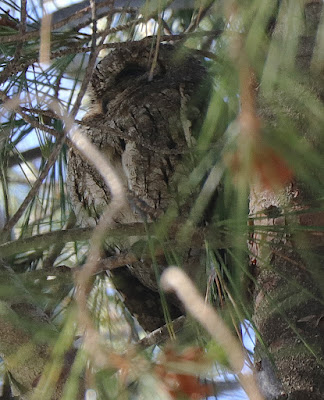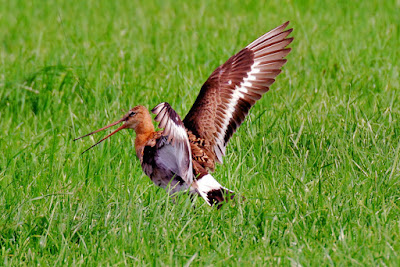We had a great time in Menorca. Two weeks of unadulterated sunshine and not a drop of rain. We visited most of our favourite island places and saw lots of birds. Birding highlights proved to be thousands of Common Swift delayed from heading north by days of northerly winds. Mixed in with the common we saw a few Alpine Swifts, Swallows and Sand Martins. We had a morning of migrating Red-footed Falcons together with superb views of a female Montague’s Harrier.
There was a disaster when on day two I damaged my Canon 400mm lens to the extent that for the rest of the holiday I had to use a bog standard 35-135mm zoom – not good for taking bird pictures. Apologies then for the lack of bird pictures but please do enjoy the extra number of photographs of sunny Menorca. Don't forget to "click the pics" to enjoy the sunshine.
We saw Scop’s Owls every evening in the hotel grounds where they appeared as if by clockwork about 2130 to feed on moths and beetles. About 400 yards away another pair of Scop’s spent their daylight hours roosting in a pine tree after annoying the hotel guests with their monotone hooting throughout the night. This owl has reputation for being hard to see as it sits motionless against the trunk of a tree. On some days both owls were sat within inches of each other but on other days just a single one would sit unperturbed as people below struggled to give definition to the dark shapes above.
Hotel Sant Tomas
Sant Tomas, Menorca
Scop's Owl
Scop's Owl
On day one, May 1st, a few late Wheatears could be seen along the hotel frontage or in the grounds. The local Turtle Doves can get fairly tame, quite unlike their country cousins who live their lives away from tourists. As ever, Spotted Flycatchers can be found near tourist spots where a 135mm lens shows how the species is tiny.
Wheatear
Turtle Dove
Spotted Flycatcher
In the centre of the picture below is El Toro, at 342 metres, the highest point of the island. There are few birds up there except for Greenfinch, Goldfinch and the ubiquitous Sardinian Warbler and House Sparrow. The many viewpoints do give good views of the island common raptors, Red Kite, Booted Eagle, Egyptian Vulture and Kestrel. Naturally there’s a shop selling tourist goods but like most places in Menorca the parking is free and there is never a feeling that visitors to the island are simply cash cows.
At Torre del Daume
View from El Toro
El Toro
Ciutadella
Ciutadella
Es Migjorn
Es Migjorn
Es Migjorn
Cookery demo - Es Migjorn
Menorcan centipede
It was on day two that I broke my lens. We had stopped at the Cattle Egret colony on the outskirts of Ciutadella and taken a few pictures before contusing on to Punta Nati and the specialities of Blue Rock thrush, Short-toed Lark, Thekla Lark and Corn Bunting.
Cattle Egret
Cattle Egret
Cattle Egrets
By early May the Menorca breeding season is well under way with most species either feeding young in or out of the nest. Upon crossing one rocky field I heard the warning “chip, chip” calls of adult Corn Buntings and within a few minutes found a young Corn Bunting hiding in the grass. Like many ground nesting birds, young Corn Buntings leave the nest before they can fly. It’s an evolutionary adaptation that lessens the chances of a nest full of youngsters falling victim to a predator whereby at least one or two young will survive to adulthood.
Corn Bunting
Corn Bunting
I tripped over a particularly well hidden rock and dropped my lens onto the stony ground. Today I’ll parcel it up and see if a lens doctor can make it better. If not, those floorboards will need to come up.
The road between Es Mercadal and Cap de Cavalleria proved the best for birding with regular Bee-eaters, Red Kite, Booted Eagle, Egyptian Vulture, Marsh Harrier, Stonechat, Sardinian Warbler, Cetti’s Warbler, Nightingale, Tawny Pipit and a mix of herons. We managed to see the regular species of Purple Heron, Grey Heron, Squacco Heron and Little Egret. It was along the same road that one morning we found a single but superb female Montague’s Harrier quartering the fields. A morning following overnight cloud and a cool start saw a movement of 15/20 Red-footed Falcons quite high in the sky and drifting steadily north. We found a single female on a roadside post which gave us a short but spectacular hunting display above a thistle-filled field before she too hurried on. When we checked the road the very next morning all the falcons had gone, along with hundreds of Swifts that had filled the sky.
To Cavalleria
Near Cap de Cavelleria
Es Prat, Tirant
Es Mercadal
Es Grau produced water birds like Coot, Gadwall, Little Grebe, Great Crested Grebe, Purple Heron, Grey Heron and Little Egret. Yellow-legged Gulls nest here but I think the much less common Audouin’s Gull nest only on offshore islands.
Hopefully I will be up and running soon with local news and my lens back in action for better photos; so log in soon to Another Bird Blog.
Linking today to World Bird Wednesday.














































































.jpg)












